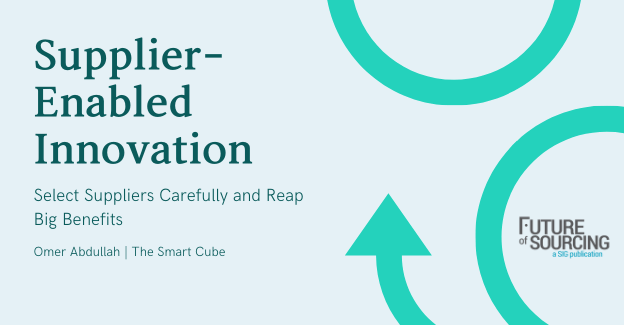Supplier-Enabled Innovation: Select Suppliers Carefully and Reap Big Benefits
Today, a lot of the low-hanging fruit has been picked by CPOs. But one area where there is significant scope for procurement to deliver value is supplier-enabled innovation (SEI). With 25% to 45% of revenues coming from product innovation and up to 65% of innovations sourced externally through external partners and suppliers, SEI represents a treasure trove of opportunity.
Why is Supplier-Enabled Innovation Important?
1. Expand Organizational Capabilities
By tapping into the capabilities and innovations of the supplier community, procurement can dramatically increase the nature and volume of research and development (R&D) work being done on their behalf. In the process, an organization can tap into the skills and knowledge base of other parties who are experts in their specific fields, leveraging their learnings to help drive the business forward.
2. Greater Cross-Organizational Collaboration
SEI, by necessity, involves multiple functions within a business, such as procurement, R&D and product development working together. It therefore encourages stronger cross-functional collaboration across business groups, driving internal efficiencies such as alignment of core goals, integration toward common results and more effective knowledge transfer. This both accelerates the overall innovation pipeline and reduces risk in the process.
3. Stay Ahead of the Competition
Picking supply partners that support finding new ways of doing things and doing them faster can help companies stay ahead of the competition. One study shows there is a 40% faster route to commercialization for externally sourced innovations. An effective, well-considered approach to SEI enables organizations to push beyond the competition in ways that couldn’t be delivered from a purely internal approach without considerable time and expense.
Choosing the Best SEI Partners
As organizations look to their suppliers to collaborate and jumpstart product and process innovation, insight and intelligence are key for understanding unmet customer needs, emerging technologies and capabilities that fill these gaps, and evolving market trends.
Diving into your existing supply base to identify the right partners will be tempting, and this approach often yields value. But the right suppliers are not always the ones you know. As such, a structured process for identifying the right partners is essential, with assessment for each of the following:
- The right skills, such as technological, quality, industrial and financial
- Collaboration ability, conveyed by strategic alignment around product/service goals, an agreement on the key values of collaboration and governance pertaining to innovation projects
- Fit, both the strategic commitment of top management and the cultural compatibility of supplier and client corporate cultures
Demonstrated results is another selection criteria, but answers will not always be found in plain sight. In fact, one very effective, yet under-used source of information for identifying innovative suppliers is patent research. This can help a function find and benchmark companies who are innovating in strategic areas of interest for a business – from finished product to packaging components, to unique ingredients to manufacturing process innovations. Equally, the performance of existing suppliers can be assessed – are they investing and innovating as one would expect?
Finally, it’s worth noting that the right choice of a supplier partner is not necessarily dependent on size or breadth of offering. Oftentimes working with a specialist company that will work more collaboratively and put more at risk for a share of the long-term spoils is worthwhile.
Ironing Out Bumps in the Road
For successful SEI, several factors need consideration during the due diligence process, when selecting suppliers:
Start at the Top
Invite the executive leadership to get their buy-in. It’s a cliché but it’s true: Executive-level sponsorship is critical for any initiative to succeed. As an example, Johnson & Johnson has an SEI team of 12 people who are tasked with sourcing cross-function innovations. All roles within the team are high-level (VP and above), which fosters a culture emphasizing innovation, tied directly to outcomes.
Sort Out the Intellectual Property Rights Ownership Upfront
When jointly generating ideas, it is important to decide in advance on a dedicated contract that sets the collaboration rules, primarily in terms of intellectual property (IP) and risk sharing. Many innovation attempts fail or are problematic due to unclear terms of collaboration contracts.
Articulate Your Innovation Goals
Innovation workshops are processes that require planning, cautious selection of ideas, IP management and decisions concerning resource allocation. Make sure the goals align for both parties right from the start and innovation workshops are treated as such, rather than as a sales channel.
Build Resources Internally to Support SEI
Companies typically create dedicated innovation teams or establish new roles and job functions specifically dedicated to driving collaboration. In addition, developing online innovation platforms that facilitate knowledge exchange across the supply chain, from startups to large companies, helps businesses partner more closely.
Reap the Rewards of Looking Out and Bringing Innovation In
There is a growing recognition of the value of broader partnerships and hybrid models that integrate insource with outsource, especially in areas as important as innovation. Indeed, in today’s complex, global ecosystem, choosing the right, innovative partnership is becoming ever more critical for success. And procurement sits at the perfect point – right at the confluence and in a position to drive transformative value for the corporation.









